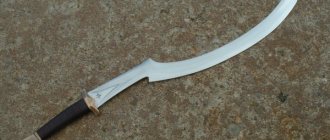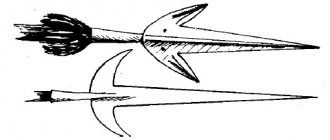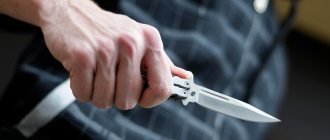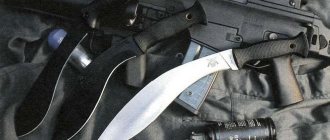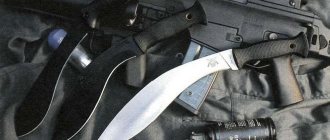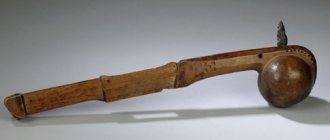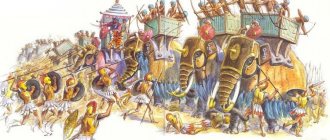Ancient Egypt is the greatest civilization of mankind, where agriculture, science, various crafts, construction and, of course, military affairs were developed at a high level. Everyone recognizes such symbols of the Egyptian military power as the chariot, helmet, knightly armor and, of course, the sickle-shaped khopesh sword.
Khopesh (khepesh, khopesh) is one of the most famous types of edged weapons of Ancient Egypt that has survived to our time.
Externally, it looks like a semicircular blade with a handle. This weapon appeared and found its wide use during the New Kingdom (16-11 centuries BC). It was the unusual curved shape that made this weapon universal; it could be used to cut, stab, and chop. It is believed that khopesh is the ancestor of bladed weapons.
Nowadays, khopesh can be found more often than others in museum exhibitions dedicated to Ancient Egypt or in computer games and films about mummified warriors. This weapon design was characteristic only of developed civilizations. The name khopesh translated from ancient Egyptian means the front leg of the animal. Moreover, some scientists specify that it is the femoral part, others - the knee. The thing is that the same hieroglyph among the ancient Greeks could mean different words.
Khopesh is unique in its design. Outwardly, it is very similar to a sickle. However, practically no other type of weapon has such a unique bend in the blade. The outer side of the blade is convex and most often it is sharpened. Sometimes both sides or only the inner side could be sharpened, but there were also examples with a unique sharpening: the far side of the handle was sharpened from the inside, and the near side was sharpened from the outside.
On average, the total length of the weapon was 50-70 cm, but there were specimens both much larger and smaller.
Where does the name "khopesh" come from?
If the burials were discovered in Middle or Old Kingdom excavations, then it is possible to assume that the shape and use are associated with the femoral part of the leg of a wild animal, for example, a goat or a bull, which was used as a hammer for delivering heavy blows.
However, khopesh dates back to the era of the New Kingdom, the period of the highest prosperity of Ancient Egypt, and according to scientists, who are based on images of ancient frescoes and excavations of tombs, it was used to deliver heavy blows to the head in order to pierce the helmet and armor. Therefore, most likely, it was the shape of the weapon, causing resemblance to the femur, that led to the appearance of such a name.
Egyptian sword khopesh: a symbol of the power of the pharaohs
Ancient Egypt is without a doubt one of the greatest civilizations in human history. The highest level of development of agriculture, crafts, science and construction provided the Kingdom of Egypt with almost two thousand years of hegemony in the Mediterranean region and the Middle East. At its height, the Egyptian state controlled not only the Nile Valley, but also vast territories in North Africa, Palestine and Syria.
But empires are not created by builders, mathematicians or peasants; their emergence requires a powerful military machine, which, without a doubt, Egypt had. The most recognizable symbols of Egyptian military power are the war chariots and, of course, the sickle-shaped khopesh sword, which was especially common during the New Kingdom, the time of greatest power of Egypt.
Khopesh (khopesh or khepesh)
– a type of bladed weapon with a characteristic sickle-shaped blade. In terms of its functionality, it is something between a sword, a saber, a sickle and an ax. Basically, cutting and chopping blows were applied with the khopesh; due to its rather specific shape, stabbing with it was quite problematic. You can also add that khopesh is one of the first types of bladed weapons that people began to use.
The name of the sword translates as “animal leg,” and historians debate which limb (or part of it) the ancient Egyptians had in mind. Some scholars argue that the name should be translated as “thigh”, others – “front leg”, and still others believe that “khopesh” generally means “knee”. The shape of this weapon actually resembled a cattle limb. However, for our further story, the exact translation of the name of the sword is not too important.
It is unlikely that the entire Egyptian army was armed with khopesh. These swords were made of bronze, a rare and very expensive material at that time. Historians believe that the khopesh was the weapon of the military elite of the Egyptian army. It is likely that this sword had great symbolic meaning and was a very status item. Various pharaohs are very often depicted with khopesh. They are often found in the tombs of nobles and kings; for example, two such swords were discovered in the famous tomb of Tutankhamun.
Story
Modern researchers have little doubt that Egypt is not the birthplace of khopesh. There are several hypotheses about where these weapons came from in the Nile Valley.
According to the first, the birthplace of this sword is Mesopotamia. Proof of this version is the bas-relief “Stele of the Kites”, dating back to the third millennium BC. It depicts the ruler of one of the Sumerian states, who rides at the head of his warriors in a chariot. So, in his left hand he holds a weapon very reminiscent of the Egyptian khopesh. It is possible that this is an Assyrian sappara - a saber that had sharpening on both the inside and the outside. Moreover, in Egypt itself, the sword appeared almost a thousand years later - already in the period of the 16th-11th centuries. BC.
There is another hypothesis; its adherents claim that the Egyptians “spied” the design of their famous sword from the Hyksos, the mysterious conquerors who invaded Egypt in the 18th century BC. We know very little about this people, who came to the land of the pharaohs from the territory of modern Palestine.
However, for the Egyptians there were also positive aspects to this story. Some historians believe that the Hyksos were armed with curved bronze swords (or knives), the successful design of which was later borrowed by the practical Egyptians. Also, the inhabitants of the Nile Valley adopted the tactics of using chariots in battle from the invaders.
One way or another, after the Egyptians drove out the invaders, the New Kingdom period began in Egypt. And the formidable Egyptian chariot warriors, armed with terrifying curved swords, began a very successful expansion in the region.
Wherever the khopesh was invented, “agricultural” motifs are clearly visible in its form; it is likely that the ancestor of this weapon was an ordinary peasant sickle. But the khopesh differs from ordinary combat sickles in the sharpening made on the outer side of the blade. If we take this feature of the khopesh into account, we should note a certain similarity between this weapon and the axe. So, it is likely that the khopesh is the result of the transformation of a battle ax.
Variants of weapons with double-sided sharpening are known.
Already by the 14th century BC. e. khopesh is found less and less often, and by the 13th century it completely fell out of use. This is probably due to the emergence of new, more accessible and cheaper types of weapons that could be used to arm a large mass army.
It is believed that the Egyptian khopesh became the progenitor of another famous type of bladed weapon - the kopis sword, which was very popular in the army of Alexander the Great and spread in different variations throughout the Mediterranean region.
Description of the weapon and features of its combat use
The length of the khopesh could be different. As a rule, its dimensions did not exceed 50-60 cm, but in some examples of this weapon the length of only one handle was 70 cm. In this case, the khopesh turned into a kind of small halberd. The shape of the khopesh blade differs in the degree of its curvature, as well as the distance from the handle to the point where the blade begins to bend. Some of the swords found have a small hook at the end of the blade, which was probably used to grab the enemy.
The handle of the khopesh could be either one-handed or two-handed.
As mentioned above, khopesh were made of bronze, so the weight of this weapon was very decent - about two kilograms. Usually the blade was sharpened on the outside, but there were also double-edged weapons. There was another interesting way of sharpening weapons: the part of the blade located closer to the handle was sharpened from the outside, and the far part from the inside. Archaeologists have discovered completely unsharpened khopesh. It is obvious that they were used for ritual purposes.
Analysis of the metal of swords found during excavations showed the presence of such rare compounds as ferrosilicomanganese and ferrosilicon. This indicates a high level of skill of ancient metallurgists.
Due to the significant cost of the metal in that era, it was likely only the very wealthy could afford it. It is possible that some ancient Egyptian elite units, such as the personal guard of the pharaoh or the court guard, were armed with khopesh. This is not known for certain.
The Khopesh was a very lethal weapon. Thanks to its shape, it could inflict very serious cut and chop wounds. Moreover, he did the latter even better than with an axe. The curved shape of the blade made it possible to strike with “pull”, like later sabers.
Several years ago, enthusiasts decided to conduct an experiment to find out how effective the khopesh was in battle. For this, of course, modern replicas of khopesh were taken, and pork carcasses were used as the “enemy”. The Egyptian sword turned out to be a terrible weapon, capable of causing fatal damage to the enemy even with one blow. It should be remembered that in the era of the spread of these weapons, only an insignificant part of the soldiers had armor.
In addition, during a battle, a warrior could use the curved butt of a khopesh to capture the enemy himself or, for example, his shield.
In general, it should be noted that the classification of khopesh also raises many questions. Despite the curvature of the blade, most researchers (probably out of habit) classify khopesh as swords and not sabers, which, to put it mildly, is not controversial. However, the khopesh with its semicircular blade is definitely not a sword; rather, it is closer to battle axes.
Its significant size, as well as a wide variety of shapes, made it possible to use the khopesh by both mounted and foot soldiers. Also suitable for chariot combat.
These Egyptian swords were not only used in war, they were also used for executions. Scientists were told about this by numerous bas-reliefs on which prisoners were executed with the help of these weapons.
The images also told us how ancient warriors typically wore khopesh. As a rule, it was simply placed on the shoulder, butt down. It was very difficult to make a sheath for a weapon of such a complex shape. Sometimes it was simply fastened to the belt.
In recent decades, the popularity of the ancient Egyptian sword khopesh has reached unprecedented heights. For this, first of all, we need to say thanks to the cinema. This weapon is constantly present in films with an “Egyptian” theme; the khopesh is also extremely popular in computer games. Even in the already cult series “Game of Thrones” based on a series of novels by Martin, the wild nomadic Dothraki use a sword called “arakh”, which in its shape is very reminiscent of the Egyptian khopesh.
Theories of the origin of ancient weapons
Most modern historians are inclined to believe that the birthplace of khopesh is not Egypt, but another country.
- One group of scientists is inclined to the theory that khopesh originated from an older analogue from Sumer (an ancient region in southern Mesopotamia). They see proof of their version in the bas-relief “Stele of the Vultures,” which dates back to the 15th century BC. On it, the head of the Sumerian state sits majestically in his chariot, and in his hand holds a weapon, very much reminiscent of a khopesh in its outline.
- According to other historians, such a sword was first used by the Sappars from Assyria, who slightly modified their local sword - the shekel, although there the cutting surface is the inner surface.
- The third group of researchers believes that the appearance of khopesh is associated with the period of domination of the invaders - the Hyksos, who may have brought it with them, and perhaps the Greeks, in the process of conducting defensive actions, invented khopesh on their own. There is still controversy regarding the origin of the Hyksos, since in the official sources of Ancient Egypt there is practically no information about this period and people. Some scientists believe that these could be foreign tribes from the territory of the Middle East, but recent research leads to the idea that as a result of an intrastate conflict, power passed to a group of local residents. However, it was the appearance of these barbarians in Egypt that led to the emergence of new technologies in agriculture, pottery production, and land cultivation. Military affairs also changed. War chariots, helmets, armor and some types of weapons appeared in Ancient Greece during this period.
- Whatever the roots of the khopesh, its connection with the usual sickle for agricultural work, which was later modified for military operations, is clearly visible.
Weapon Description
Bronze was traditionally used to make the sword, which made the khopesh heavy and durable. But the analysis of some artifacts showed the presence of impurities of such rare metals as ferroscilium and ferrosilicomanganese, which is evidence of the great achievements of Ancient Egypt. The blade was curved into a sickle shape. Only its outer edge needed to be sharpened. Less common were double-edged options: the edge located closer to the handle was sharpened on the outside, and the end of the blade was sharpened on the inside.
Hittite Khopesh
The length of the handle is mainly designed for two hands, but sometimes small one-handed khopesh were also made. The total length of a full-fledged sword is 50 – 70 cm. But there is a lot of evidence that in particularly large specimens the handle alone reached the specified length.
The khopesh was carried without a sheath in two ways: most often on the shoulder (with the concave, non-sharpened side inward); less often - fastened to a belt.
Combat use of khopesh
In terms of its functionality, it is something between a sword, a saber and an ax. In any case, he very successfully combined the features of these weapons. Khopesh has very high penetration ability. He is able to chop, stab, cut.
The semicircular blade of the weapon could have either a well-defined tip, apparently for delivering stabbing blows, which, as practice shows, is not very convenient to do with this type of weapon, and there were samples with a kind of hook at the end of the blade, most likely in order to pick up , for example, an enemy, throw him off a horse or chariot and then deal a fatal slashing blow. Due to the weight of the weapon, the handle of the khopesh could be either one-handed or two-handed, which made it possible to freely hold it with both hands at the same time, and, therefore, it became possible to strike the enemy while standing in a chariot or sitting astride a horse, it was possible to cut off the head or, for example, an opponent's limb.
The wounds inflicted by the khopesh were deeper than from the same battle ax, similar to a wound from a saber, but this weapon was never considered a saber.
Perhaps this is a battle ax that has undergone modification, in which the weight has increased, a cutting surface has appeared, and therefore the weapon has the ability to deliver secant blows. The weight of the khopesh is about two kilograms, and the weight of some specimens reached 4 kg. The reason for this is the material from which it was made. It was bronze, since it was the type that could be mined by open-pit mining and did not require complex structures for remelting. And since bronze is softer than steel, the weapon had to be made thick-walled to obtain the necessary rigidity. It was the weight that contributed to such a powerful blow. The edges of the wounds from the khopesh turned out to be almost smooth and long, which delayed their healing, and recovery was long and difficult.
Modern experiments by researchers on pig carcasses have shown that the khopesh is a truly terrible weapon, the blow of the khopesh is really powerful, and with a well-sharpened blade, cutting the bone is not difficult. Just one blow could be fatal.
With the help of khopesh in Ancient Greece, not only military problems were solved, but also executions were carried out. In ancient Greek mythology, the gods were quite harsh and mercilessly punished mortals for their misdeeds. People imitated their gods, so the laws of Ancient Greece were also strict.
The death penalty could even be imposed on someone who picked a handful of grapes in someone else’s garden. Execution was common in ancient Greece. Scientists came to this conclusion by studying the bas-reliefs of that time. One of the methods of execution was cutting off the head; it was also chopped off as proof of victory over the enemy; it was customary to cut off the head of a prisoner and deliver it to the enemy. Khopesh, having a curved shape, was perfect for this purpose.
Description of the sword
During the New Kingdom, high-quality weapons were made mainly from copper and bronze. This metal was more accessible in those days. The mines extracted copper and tin using the open-pit method acceptable at that time. In addition, processing of the alloy did not require complex technological processes.
However, bronze was valued at that time, and metal products, including weapons, were available mainly to wealthy people. In the army, wealthy warriors in high ranks were armed with swords and daggers.
Bronze is a fairly heavy metal, and the khopesh produced from it had significant weight.
Archaeological excavations in the areas where the Nile River widened have discovered new burial places for the highest ranks of Ancient Egypt. Well-preserved weapons were found in the tombs, among which was the khopesh sword.
When examining the sword alloy in the laboratory, it was found that the structure of bronze contains ferrosilicon and ferrosilicomanganese ferrosilicon additives.
These components gave the metal additional strength. Thus, the conducted hydrocarbon studies make the discovery that metallurgy in Ancient Egypt was at a high level.
The sword was sharpened from the outer edge. Sometimes archaeologists came across swords sharpened on both edges.
A blow with the inside of the blade was most likely used to cut off a head or limb.
The long handle of the sword made it possible to hold it freely with both hands. The total length of the sickle-shaped blade ranged from 50 to 70 cm, and such a sword weighed about two kilograms. However, specimens have been found reaching a length of more than one meter and weighing up to four kilograms. Most likely, a large specimen was used in ritual ceremonies.
The unsharpened inner side of the sword made it possible to carry it on the shoulder. This position can be found on ancient Egyptian frescoes. Small blades were worn on a belt near the hip. This type of weapon did not have a sheath.
Elite weapon khopesh
Khopesh can be called a symbol of the New Kingdom era. At the same time, many historians are inclined to believe that the entire Egyptian army could not be fully armed with it. It was believed that only wealthy Egyptians were able to wield metal weapons; it was a luxury item. It could have been among elite military units and skilled fighters, as well as among the Pharaoh’s guards.
Khopesh was an indicator of the status of an Egyptian. In ancient images inside the pyramids, many pharaohs were depicted with these weapons. There was often an image where warriors carried their weapons on their shoulders (the concave side of it was not sharpened, which did not interfere with this method of wearing), they were also attached at the hip or on the belt; it did not have a sheath.
The khopesh did not become widespread, since arming a large army required a lot of expensive metal, and the bulk of the army consisted of poor people; they could not afford such luxury on their own, so they were armed with battle axes, bows and spears. To wield a sword, special training was required. Therefore, they were available only to organized armed groups supported by the state. Khopesh was used by fighters, both infantry and cavalry, as well as chariot warriors.
Ancient Egypt loved all kinds of ceremonies, so these weapons could often be found in the tombs of the pharaohs. For example, during excavations of the tomb of Pharaoh Tutankhamun, who died around 1327 BC. e., two khopesh were discovered at once. In some tombs, khopesh were preserved in fairly good condition; scientists conducted a deep hydrocarbon analysis of these swords and found some impurities in their composition - ferroscilium and ferrosilicomanganese, which gave the weapon additional strength. These studies indicate that weapons manufacturing in those days was developed at a fairly high level. Moreover, more often than not they were not sharpened; apparently they had a ceremonial status.
Already by the 14th century BC. e. khopesh is becoming increasingly rare. And the weapon went out of use around 1300 BC, although many historians agree that it did not disappear, but was modernized to meet new requirements, for example, in kopis - this is a dagger in the army during the time of Alexander the Great or a curved weapon in the army of the Persian king Xerxes.
Scientists believe that the shape of the khopesh subsequently influenced the shape of many types of bladed and polearm weapons, for example, the Turkish scimitar, the Russian bait knife, and the khurki, the national knife of Nepal.
History of origin
The main combat skill of the Egyptian warrior was mastery of weapons: sword, spear, battle ax. A soldier skillfully wielding weapons was a dangerous adversary. Before the New Kingdom, the army was weakly armed with spears and wooden shields. A little later, bronze axes appeared.
Starting from the reign of the 18th dynasty, reforms were carried out in the troops. Warriors began to actively use horses and war chariots. A kind of chopping and cutting weapon appeared.
Advance detachments, armed with an unusually shaped ax sword, inflicted deep cutting injuries on the enemy, practically incurable, given the level of development of medicine at that time.
Thus, the Egyptian khopesh won the respect of the generals and became the main weapon, along with the bow, spear and battle ax, in the army of the New Kingdom of Ancient Egypt.
The shape of the khopesh sword was partially borrowed from the Hykos, who invaded Egypt and conquered part of its lands during the reign of the XIII-XVII dynasties. The Hykos armies fought with curved swords, which were countered by the battle axes of the Egyptians.
The defeats of the army, as well as significant losses in close combat, forced Egyptian commanders to think about more effective weapons. The Egyptian army began to transform. In addition to war chariots, sickle-shaped swords appeared. Such a decisive step in updating the ammunition brought positive results.
The modernized Egyptian army not only recaptured previously lost territory, but also conquered new lands.
The Egyptian sword khopesh became one of the symbols of the military successes of the New Kingdom. It is worth adding that most of the Egyptian regiments were formed from peasants who did not possess combat skills.
In addition, khopesh was made of bronze, and this metal was brought to Egypt and they tried to use it sparingly. Mostly, sickle-shaped swords were used by the elite assault troops, the palace security service and the pharaoh's personal security service.
The peculiar shape of the blade bears a significant resemblance to the battle ax of the Middle Kingdom.
Combining the two types of weapons increased the characteristics of the new sword. Historians are inclined to this opinion. However, there is a version about the origin of khopesh from the sickle-shaped Assyrian blade - sappar.
It had an internal sharpening and could be used as an agricultural tool. But the first path of evolution of the ax sword looks more plausible.
The shape of the blade will remain unchanged for many centuries and will serve as a prototype for the creation of weapons in the armies of some ancient states. For example, a small part of the soldiers of Alexander the Great had swords - kopis, with slightly curved blades and similar to the ancient Egyptian sword of the New Kingdom of Egypt.
During the reign of Xerxes from 486 BC. uh, his Persian army was equipped with curved blades.
Interesting facts about khopesh
- Many scientists believe that it was this type of weapon that became the progenitor of the class of swords; in any case, to date nothing similar has been found that would be related to earlier periods.
- Historians still argue whether these weapons were used in battle or were simply ritual.
- Despite its venerable age, khopesh continues to live. In the last few decades, it has received its rebirth, but in computer games and cinema. For example, in the movie “The Mummy”, the Egyptian mummified warriors used khopesh. The series “Game of Thrones” is widespread, in which the “arakh” sword is very similar in appearance to khopesh.
Artifacts
According to historians, the khopesh is the first weapon on earth that can be classified as a sword. This is also confirmed by archaeologists, because earlier varieties could not be found. At least for now.
As mentioned above, evidence of the use of khopesh by the ancient Egyptians comes from wall paintings found inside the pyramids. The images show the kings of Egypt holding exactly such swords in their hands. And during excavations carried out in the tomb of Tutankhamun, archaeologists also found samples of these weapons.
Copis of Alexander the Great
The army of Alexander the Great, who conquered half of the ancient world in the 4th century BC, used curved swords called copis. Many researchers believe that they originated from the Egyptian khopesh. The kopis had a sharpening on the inside and resembled a Turkish scimitar. Presumably, the copis came to Alexander’s soldiers through the Persians. The Roman author Curtius wrote that the Macedonians began to use this type of weapon en masse during the Indian campaign: “Slightly curved swords, similar to sickles, were called copids; they were used to chop the trunks of elephants.” However, kopis never took root in Greece. After the death of Alexander the Great, it was used in battle very rarely. But this blade shape was very popular with the Iberian tribes that inhabited Spain. From them, copis came to the ancient Romans, who called them fulcata, or simply “Spanish sword.” They were used to arm the cavalry, since the curved blade allowed the rider to hit harder, inflicting terrible wounds. With a fulcata, a Roman horseman could cut off an enemy's arm with one blow.
From rituals to the battlefield
Initially, khopesh was considered a ceremonial weapon, and only warriors who were in the personal guard of the pharaohs were armed with it. This was explained by the fact that it took quite a lot of bronze to make khopesh, so their mass production was difficult and expensive. In addition, the very appearance of the intricately curved blade, which the tall bodyguards carried, placed on their shoulders, without a sheath, made a terrifying impression on those around them. Ritual, non-combat khopesh were also used by the pharaohs themselves in various religious rituals. This weapon was considered a symbol of supreme power, military victories and the greatness of the pharaoh. After some time, khopesh found its way onto the battlefield as a military weapon. They were armed with nakhtuaa - a category of well-equipped infantrymen in bronze helmets, leather armor and large shields. They fought in close formation, like the Greek phalanx. At first, their main weapons were bronze hatchets. But then they were replaced by more universal khopesh. In addition, warriors who went into battle on Egyptian chariots fought with khopesh.
In this case, longer and heavier specimens were used, the blows of which were applied with both hands. In general, the attack of the Egyptian army of the New Kingdom era looked something like this. The archers were the first to start the battle, raining down a cloud of arrows on the enemy. Then chariots, from which they threw darts, crashed into the ranks of the enemy army, and then powerful blows of two-handed khopesh fell. After the enemy's formation was broken, the Nakhtu-aa infantry took over. When approaching, they also threw darts, and then used hatchets and khopesh. This “three-layer” attack provided a significant advantage for the Egyptians in almost any battle.
Not a saber or an ax
The curved shape usually makes the khopesh comparable to a saber or even a scimitar. But weapon historians are inclined to believe that it is related, rather, to an axe. This paradoxical conclusion is explained by the fact that, apparently, the khopesh was not cut “with a pull,” but simply hit from top to bottom. The damaging effect was ensured rather by the weight of the weapon than by the bending or striking technique. A complex theory of fencing did not yet exist, so the complex form of khopesh was explained more likely by ritual than by applied reasons. The fact that there was no single technique for wielding a complexly curved bronze blade is also evidenced by the fact that the khopesh was sharpened in different ways. Sometimes the outer side of the sickle was sharpened, sometimes the inner side. There is also an original sharpening option, when the straight section of the blade was sharpened on the outside, and the sickle on the inside. There were also double-edged khopesh. Finally, khopesh are sometimes found in burials that were not sharpened at all. Regarding the latter, there is a well-founded hypothesis that they had a purely ritual significance.
The ratio of the straight section and the bend is also not always the same - on some specimens the short sickle is located at the very end of the blade. The bend that forms the sickle can be quite smooth, or it can be emphatically sharp; in the latter case, the khopesh really looks like an ax in shape. The average length of a khopesh blade is 50-70 centimeters, although, again, the discrepancy in size is quite significant. Thus, in some specimens the length of the handle alone reaches 70 centimeters. Such specimens look more like shortened halberds than swords. However, khopesh also have handles for one palm. The width of the blade ranged from 3-6 centimeters. At the same time, like all bronze weapons, the thickness of the blade is quite large - up to one and a half centimeters. With such dimensions, the khopesh had a very significant weight - up to several kilograms. This made his blows crushing, from which neither shields nor armor could protect him. But at the same time, the demands on the warrior who fought with khopesh increased; he had to have outstanding physical strength.
